Ossian’s Cave
Useful Information
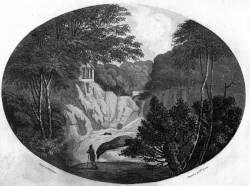
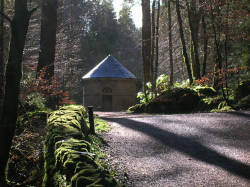
| Location: |
Old Military Rd, Dunkeld PH8 0JR.
North of Dunkeld. A9 between Perth and Pitlochry, north of Dunkeld, signposted. After turning off take the first right, the at the parking lot keep right again and follow Old Military Rd to the end. (56.55584, -3.62002) |
| Open: |
no restrictions. [2023] |
| Fee: |
free. Car Parl GBP 3. [2023] |
| Classification: |
 Grotto Grotto
 Cave House Cave House
|
| Light: | bring torch |
| Dimension: | |
| Guided tours: | self guided |
| Photography: | allowed |
| Accessibility: | no |
| Bibliography: |
Dorothy Wordsworth (1894):
Recollections of a Tour Made in Scotland AD 1803
Edinburgh : David Douglas. page 210
T. Garnett (1811): Observations on a Tour through the Highlands and part of the Western Isles of Scotland; particularly Staffa and Icolmkill Vol. 2 (new ed.). London: John Stockdale. pp. 69–70. online |
| Address: |
The Hermitage, Old Military Rd, Dunkeld PH8 0JR, Tel: +44-1350-728641.
E-mail: |
| As far as we know this information was accurate when it was published (see years in brackets), but may have changed since then. Please check rates and details directly with the companies in question if you need more recent info. |
|
History
| 1757 | Hermitage and Ossian’s Hall of Mirrors built. |
| 1783 | redecorated as a shrine to the blind bard, Ossian. |
| 1869 | vandals blow up part of Ossian’s Hall as a protest against toll charges on the bridge at Dunkeld levied by the 7th Duke of Atholl and the area is left to decay. |
| 1943 | donated by the 8th Duchess of Atholl to the National Trust for Scotland in accordance with the wishes of the late Duke. |
| 2007 | Ossian’s Hall restored. |
Description
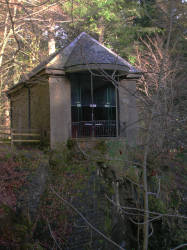

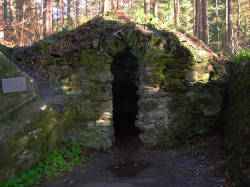
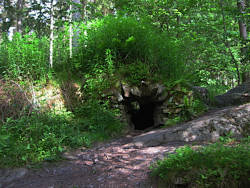
The Hermitage pleasure ground, is a historic site which is protected by the National Trust for Scotland. The forest at Dunkeld contains a building which is today called Ossian’s Hall of Mirrors, most people come to this place to see this building. It was erected as a so-called "view-house" on a rocky outcrop overlooking the Black Linn Falls of the Braan, a tributary of the River Tay. It seems the Victorians already understood that nature looks much better, if it is framed. It was a summerhouse built as a retreat from the pressures of daily life. Ossian’s Hall was built in 1782–1783 to replace the summerhouse. A second building is called Hermitage or Hermit’s Cave, although it is actually a sort of circular garden grotto. But unlike such grottoes it is not decorated in any way, there are only the natural rocks of the walls. The cave has a narrow and high entrance with a barrel vault on one side, and two windows with a barrel vault on the opposite side, so a lamp is actually not needed. The cave house is covered by earth and overgrown by gras and weeds. Both buildings were erected for the 2nd Duke of Atholl in 1757. Actually it is not exactly known when the cave was built, estate records suggest that the cave was possibly built in 1755, before Ossian’s Hall. There is a theory, that Hermit’s Cave was supposedly built around 1760 for the third Earl of Breadalbane, who unsuccessfully advertised for a permanent eremite. But there are no visitors’ accounts until 1776.
Ossian’s Cave is an enhanced natural feature, there were several large boulders which formed a small tectonic cave. The cave was extended by a corbelled roof made up of stones. Inside the cave, is a low stone seat, about 1.5 m in length, 0.3 m from the ground. The site is describes as a folly, which means a structure with little or no practical purpose. Popular in 18th century landscaped gardens, they were towers, castles, temples, cairns and hermit’s cells. It was quite popular to imitate natural structures or build ruined castles.
In 1783, John Murray, the third Duke of Atholl, created a sort of forest park on the banks of the River Braan in Craigvinean Forest. This included both buildings. The view-house was redecorated as a shrine to the blind bard Ossian. That’s when it was renamed Ossian’s Hall of Mirrors and the Hermit’s Cave was renamed Ossian’s Cave. There also was an inscription placed inside the cave, purported to be an Ossianic poem, which has vanished without any trace.
In the 18th century the celtic bard Ossian became quite popular. But it seems he never existed, he was purported as the author of a cycle of epic poems published by the Scottish poet James Macpherson. He published two books, Fingal (1761) and Temora (1763), and later combined under the title The Poems of Ossian. He claimed that he had collected word-of-mouth material in Scottish Gaelic, which he thought to be from ancient sources. The name Ossian is based on Oisín, son of Fionn mac Cumhaill, a legendary bard in Irish mythology. But today its consensus, that Macpherson largely composed the poems himself, only using ideas from traditional Gaelic poetry. He intended to make his poems more interesting by attributing them to an ancient source. Intended to evoke features of shock and amazement in the viewers’ minds, the hall was lined with mirrors which reflected the waterfalls from all directions. There was a painting of Ossian serenading a group of maidens which was pulled into a gap in the wall by an apparatus operated by the guide.
The 7th Duke of Atholl introduced toll charges on the bridge at Dunkeld in 1868. As the hall was partly blown up by gunpowder subsequently, it is thought to have been a protest against the toll. The identity of the miscreants was more than suspected, but they were never convicted of the dastardly act. The hall was repaired, the painting of Ossian was replaced by a portrait of William Duff. He was a local ghillie, also known as ‘Beardy Willie’, and was a favourite of Queen Victoria. However, the popularity of the site ceased and by the early 20th century it was derelict.
In 1943 the private property was donated by the 8th Duchess of Atholl to the National Trust for Scotland in accordance with the wishes of the late Duke. It 1951 the Trust salvaged and simplified the building. The current state is a result of a 2007 renovation, for the 250 years anniversary of its original construction. The Victorian ideas of shock and amazement were reintroduced. The new picture of Ossian is printed on a mirror though, and there is no mechanism to make it vanish.
The park has numerous other sights. One is the forest with its numerous tress. There is a totem pole, and a so-called Coin Stump. And of course there are the waterfalls.
- See also
 Ossian
Ossian Search DuckDuckGo for "Ossian’s Cave Dunkeld"
Search DuckDuckGo for "Ossian’s Cave Dunkeld" Google Earth Placemark
Google Earth Placemark The Hermitage, Dunkeld - Wikipedia (visited: 01-JUL-2021)
The Hermitage, Dunkeld - Wikipedia (visited: 01-JUL-2021) Ossian’s Hall of Mirrors - Wikipedia (visited: 25-JAN-2023)
Ossian’s Hall of Mirrors - Wikipedia (visited: 25-JAN-2023) The Hermitage - National Trust for Scotland (visited: 01-JUL-2021)
The Hermitage - National Trust for Scotland (visited: 01-JUL-2021) Ossian’s Cave [Dunkeld] (visited: 26-JAN-2023)
Ossian’s Cave [Dunkeld] (visited: 26-JAN-2023) Dunkeld, The Hermitage, Ossian’s Cave (visited: 26-JAN-2023)
Dunkeld, The Hermitage, Ossian’s Cave (visited: 26-JAN-2023)
 Index
Index Topics
Topics Hierarchical
Hierarchical Countries
Countries Maps
Maps